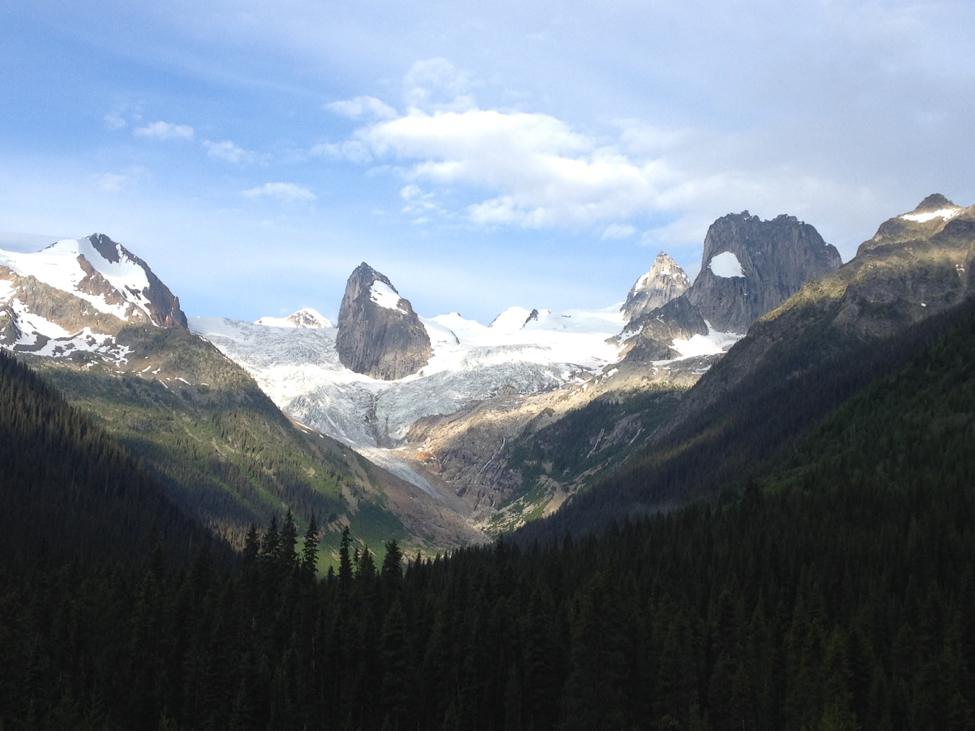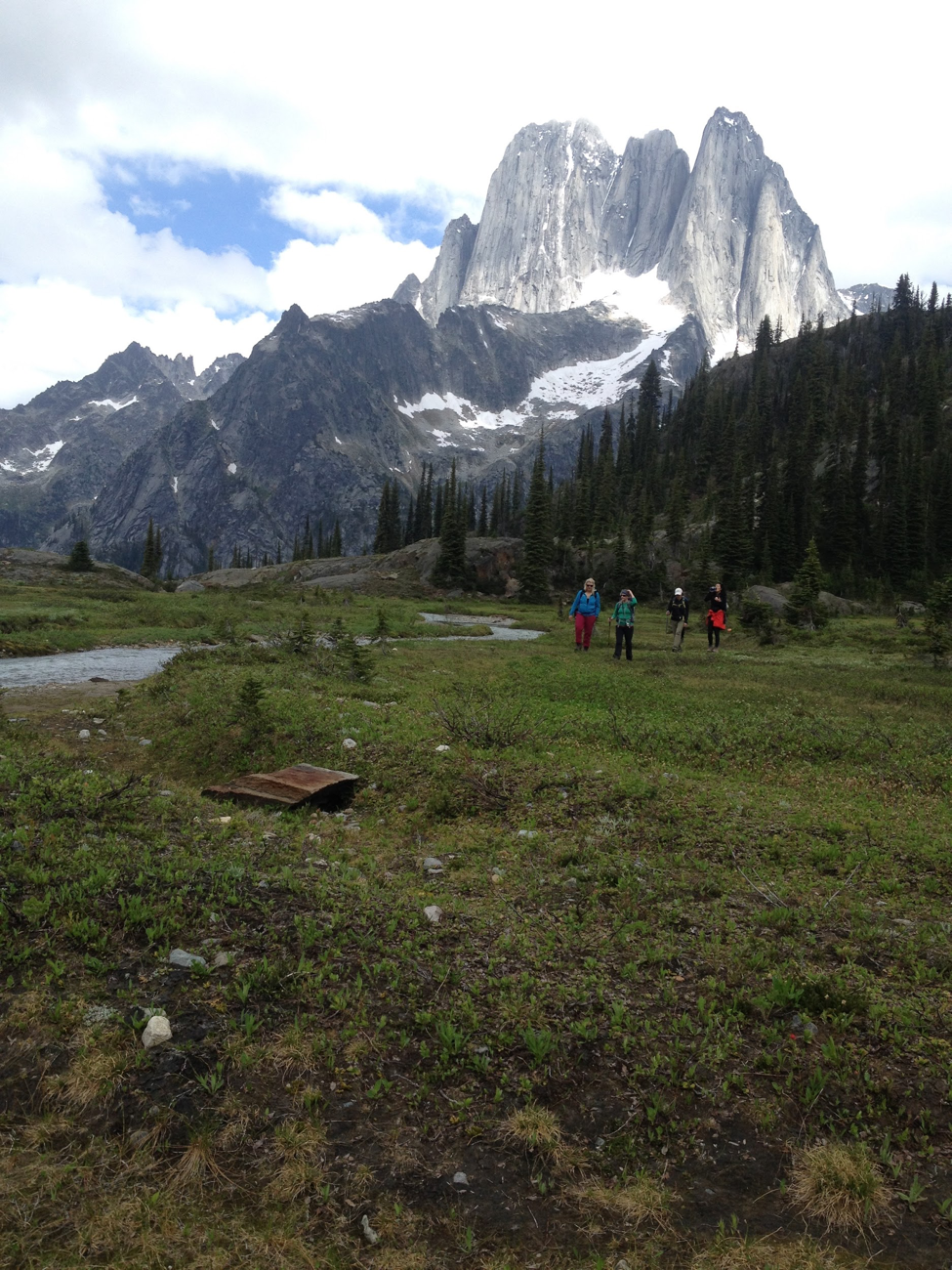For 75 million years, the granite spires of the Bugaboos in the Columbia Mountains of British Columbia have looked the same. Tropical forests have come and gone, and the valleys have filled with glaciers thousands of feet thick and then been scraped out and filled back in with grass. The peaks appear taller and taller as everything around them is carried downhill, but any climber would have been able to recognize Howser or Hound’s Tooth Spires if he or she visited 1,000 years ago, 10,000 years ago or even 10 million years ago.

Throughout history, the peaks were untouchable to most. Local Kootenay people came to inhabit the region around 10,000 years ago and would have ventured up high occasionally to hunt mountain goats but usually stayed closer to the Columbia river in the valley below. The name Bugaboos comes from the prospectors looking for gold who didn’t stay for long (a “bugaboo” being a grave disappointment), but it was their explorations that gave rise to mountaineering in the area.
When I told people I was going to the Bugaboos in July, they responded with either “I didn’t know you were a climber” or “Is there still snow up there this time of year?” Because the Bugaboos are known for world-class mountaineering and backcountry skiing. I am neither climber nor skier. I was visiting Canadian Mountain Holidays (CMH) Bugaboo Lodge in July for “heli-hiking,” which sounds like an extreme sport, but really heli-hiking is using a helicopter to access remote wilderness hiking just as heli-skiing uses a helicopter to access fresh high-elevation powder.

CMH operates twelve lodges in the Columbia Mountains and heli-skiing trips are the company’s bread and butter (fresh-baked artisan bread and Irish butter, that is -- the food at all of the backcountry lodges is gourmet). CMH invented heli-skiing in the late 1960s, taking post-war choppers up the mountain from old logging camps. Wintertime guests make up 90% of CMH’s business, but they open two of their lodges up, the Bugaboos and Bobbie Burns, for the short alpine summer season. And why shouldn’t they? They have the lodges, the guides, the chefs and the helicopters.
It was Arthur Tauck Jr., considered the father of luxury adventure tourism, who supposedly invented heli-hiking or at least proposed the idea in the late 1970s to Hans Gmoser, who was running CMH’s lodges for skiing-only at the time. Tauck wanted older travelers to get to be up close and personal with alpine meadows and retreating glaciers. The idea was to use helicopters for access -- so that people could go hiking in places they couldn’t hike to otherwise.
The only thing extreme about heli-hiking is the scenery and extreme is the right word for it. It’s like being flown into a landscape painting. From the Bugaboos Lodge, you’re looking up at the dramatic granite spires of the range out the dining room window. It’s so grandiose it seems two-dimensional, and yet over your perfect pancake and poached egg, your guide is pointing up at the view and asking you where you want to go, like it’s a map. After breakfast, you’re in a large Bell helicopter with a group of eight to ten other hikers and then, six minutes later, you’re there -- you’re in the scenery. It really is magical.

And because the term heli-hiking isn’t so much about the activity itself, but more about the access to the mountains, it doesn’t fully encompass everything on offer at the Bugaboos and Bobbie Burns Lodges. The operation at Bobbie Burns specializes in “high flying adventure” and guests can access (via helicopter of course) the longest via ferrata in North America from that lodge. The summer season for CMH is short -- August and September. These “Summer Adventures” last for three nights, with full days of hiking, climbing and ziplining in between. CMH caters to families during the summer. Children from age five and up can stay in the lodges, and heli-hiking and the via ferrata are for adults and children twelve and up.
Some of the lodges’ summer visitors are winter customers who want to see the Bugaboos covered in wildflowers rather than snow, but while heli-skiers come from all around the world to CMH lodges, heli-hikers tend to book from within British Columbia or neighboring Alberta. Why guests won’t come from farther afield to experience this world-class destination is a tough nut to crack for CMH.
“We have a few key partners that we have been working with for many years,” says Amanda Hudson from CMH’s sales office, “however we see a lot of opportunity to expand beyond big wholesalers and work with smaller, adventure focused operators.”
With me at the Bugaboos Lodge was a group of these smaller, adventure-focused industry people -- mostly bloggers and popular Instagrammers from Canada and the U.S., but also some specialty travel advisors and destination marketing representatives. CMH treated us to a remarkable weekend of heli-hiking (and excellent networking in the hot tub with possibly the best view on the planet) just a few days before they welcomed their first guests of summer 2016.
The product from CMH Summer Adventures is top-notch. The service is excellent and their guides are some of the best I’ve ever met. The location is off-the-beaten-path in the best way, but still easy to get to (guests fly into Calgary and make their way to Banff, usually for an overnight, before a very scenic two-hour bus transfer to the heli-pad, which is a short ten-minute flight from the lodge). So, why isn’t there the international mix of guests in the summer as there is during the winter?
The ATTA is starting to see a number of North American winter destinations, mountain towns and ski areas expand their visitor seasons like this. The typical approach to attracting “off-season” guests is to host events like races or concert series. Some destinations invest in attractions like golf courses or ziplines. “But is seems to me that there’s another alternative,” says Russell Walters, the ATTA’s North America Director, “...the opportunity to develop experiences utilizing unique local assets.”
Combining natural elements (rivers, trails, beauty) that automatically come with mountain destinations with local operators and knowledgeable guides is a recipe for good adventure experiences.
“Clearly, CMH lodges aren't your typical ski-resort or mountain town,” says Walters, “But as they start to craft summer experiences that combine their unique natural assets with professionally guided experiences one cannot doubt that they will be successful in establishing themselves as a leader in summer adventure travel just as they have in the winter heli-ski sector.”
Sure, the miners struck out when they sought gold in the Bugaboos, but summertime travelers to CMH’s lodges could strike it rich in the experience-economy.
